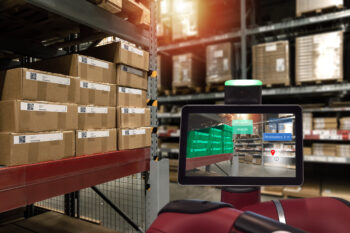Top 5 e-Commerce Logistics Trends in 2022
The e-commerce landscape will continue to change in 2022. The last two years have taught us that we must be both flexible and agile in a competitive and growing market. There has been an unprecedented growth in online retail, especially in direct-to-consumer services in 2021. A major focus is on providing omnichannel services where customers enjoy a unified shopping experience, whatever the channel. This could be in-store, online, via mobile or social media. Customers now expect a seamless process, low prices, faster shipping and a stronger focus on sustainability.

Challenges have included an extraordinary demand in the grocery and apparel segments where one-day deliveries, or less, are becoming the norm. In 2021, we have experienced a global shortage of transport capacity and a limited supply of delivery drivers. But many e-commerce companies are not maximizing the capacity they have. A real game-changer in 2022 will be in the acceptance and application of new technologies and automation. We will see solutions such as Amazon Scout -a fully autonomous-delivery system that rolls along the pavement at a walking pace and delivers directly to customers.
E-commerce logistics will continue to evolve to keep pace with expanding consumer expectations. The Supply Chain Consulting Group has identified 5 main trends for 2022:
- An increase in demand for 3PL services
The demand for outsourced third-party logistics (3PL) services will continue as e-commerce sales grow. 3PLs will expand their offerings to include providing distribution facilities in multiple locations to offer more efficient order processing and fulfillment. In 2022, we are likely to see more micro warehouses in urban areas, closer to the customer. Retailers that operate more than one distribution facility will be able to manage increases in order volumes, have better inventory management and achieve shorter delivery times.
- Direct-to-consumer (D2C) fulfillment
There will be a visible move towards manufacturers of branded goods marketing and selling products directly to the consumer. For the manufacturer, it gives them direct access to their customer, allowing greater control over branding, reputation and customer service. Gymshark, a UK-based fitness apparel manufacturer has built a market of passionate fitness enthusiasts through influencer marketing and sales via social media. Gymshark was launched in 2012 and reached a turnover of £260.6 million in 2020. Success in a D2C business demands a strong fulfillment strategy with an ability to scale quickly. D2C businesses can also partner with 3PLs as they grow.
Reverse logistics will be a factor in 2022.

Returns used to be a lot simpler when companies only operated out of brick-and-mortar stores. Optimising reverse logistics is essential, e-commerce companies must be able to handle goods flowing back in as efficiently as it does for goods flowing out. Where the cost of a return outweighs the value of the item there must be a process to handle this to avoid losing money.
- Optimising last-mile logistics
The “last mile” is one of the most critical processes in e-commerce logistics as it involves the conclusion of the delivery to the customer. It has a vital influence on the overall delivery experience and customer satisfaction. There are many innovations are aimed at solving the last mile challenge. These include light electric vans, eCargo bikes, autonomous vehicles and drones. Amazon Prime Air is leading the way in flying drones, offering 30-minute delivery to some customers. Starship Technologies uses small, six-wheeled drones to move goods within a small radius, and has completed 2 million deliveries as of 2021.
While the technology makes major progress, there is a way to go to improve the supporting infrastructure and reduce the high cost of the equipment. There is considerable interest in “last mile as a service” (LMaaS). We expect that some 3PLs will try to focus more on these last-mile opportunities. They can offer affordable rates by optimizing transport routes while providing live delivery updates to customers.
- An increasing focus on sustainability
Sustainability in logistics continues to be a business imperative. E-commerce companies that have defined a sustainability strategy and managed to implement it are seeing a significant competitive advantage in the marketplace. According to a recent survey by McKinsey, people now prefer a brand that is actively making sustainability efforts to become greener. Over 70% of consumers would pay a 5% price premium for products of equivalent quality produced by more sustainable means.
Any company can reduce its carbon footprint through the better use of fuel-efficient vehicles. Micro warehouses can also contribute to minimizing carbon emissions as well as improving the speed of delivery. Recyclable and efficient packaging is now an expectation by customers – it is both eco-friendly and reduces shipping costs. Collaborating with suppliers on sustainability initiatives promotes innovation, customer loyalty, saves on input costs and limits supply chain risk.
- Technology will continue to be the enabler
Cloud-based solutions that provide access to real-time and reliable information will be the key to making informed decisions and reducing inefficiencies. Digital transformation programs and the adoption of 5G have contributed to the fast take up of software solutions – the latest developments in AI and internet of things (IoT) tools will contribute further.

In 2022, the automation of processes in logistics is predicted to continue. Real-time tracking and location systems will continue to be applied in transport logistics to ensure the safety and security of cargo and drivers. There is a need for more transparency and better-quality assurance (QA) in logistics that technology tools can provide. Full visibility of location and condition of shipments means that problems can be tackled immediately reducing downtime. Collating data on consumer purchasing behaviour and applying the information in practice will be key to keeping up with the competition.
The key to e-commerce success will be through manufacturers and retailers collaborating with logistics partners to drive continuous improvement. Technology tools will help by providing the required transparency and visibility. Our supply chain consultants are experienced in carrying out projects for clients across a range of sectors and briefs and therefore have the experience to advise in this matter. Please contact us to discuss your requirements in further detail at 01926 430 883 or email [email protected].














